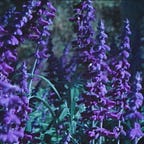IV. Notes From My Mind’s Eye
Visual Element : Color
If They Don’t Give You A Seat At The Table, Bring A Folding Chair — Shirley Chisholm
Color | Illuminating Reflections
The versatility of color adds to the arsenal of symbols previously discussed and expands our vocabularies’ range. A barometer for deciphering natural elements, color is a phenomenon we rely on daily to organize incoming information. The pigments we see from varying reflections of light is commonly accepted as color. Present in most contemporary works of art, we associate colors with our experiences of cultural messages and nature.
Namsa Leuba | 1982 — present
The color contrast utilized in Namasa Leuba’s Ya Kala Ben series is immaculate. With no context to the meanings behind the images, we can quickly sense the resounding harmony. This close attention to color mellifluously guides us into each image, helping us understand the relationship between color and symbolism.
For The Beauty Of The Rose, We Also Water The Thorns — African Proverb
In viewing Ya Kala Ben in part instead of as a whole, we must consider minute details. However monotonous this may seem, bare with me through the process to form complete understanding about the parts as a whole.
img. 1 Ya Kala Ben
The color green is commonly recognized as a representation of Earth. Green also serves as the dominant color within this composition. The foreground contrasts the orange soil filled background. The subject is holding 3 sticks Holding three sticks pointed at the ground.
Statuette Vili Fanta
Blue represents the water. The cool subdued color of the background creates a calm tone, foundational for the saturated foreground colors that add depth to the calming atmosphere. The black woman’s body separates the other wise monotone foreground — background combination.
img. 2 Ya Kala Ben
Notice the little water puddle underneath the feet of the subject. Green tree background symbolizing vegetation, growth and life. This image is a host of deeply saturated cool colors separated by a teenaged black body which is used to create contrast.
img. 3 Ya Kala Ben
Yellow is symbolic of air and intellect. White represents purity and light. This harmonic color palette, uses subtle differences in hue to represent the colors working in tandem. The young black body is the dominant color, standing out into the foreground as the entity that creates contrast.
Color | Storytelling
Previously discussed, Symbols, are simply visual idioms illustrating meaning indirectly. Our most common symbols are cultural, religious, shape, and color, all of which conveys intricate information within a complex work of art. Taking into account the innumerable uses of symbols, we look closer at color as we put the parts of Ya Kala Ben series together as a whole. Refreshing our observations of Img 1 Ya Kala Ben, Statuette Vili Fanta, & Img 3 Ya Kala Ben, these are the elements earth, water, & air. The earth is the foundation working against us to keep us still. The light is the ever flowing pure source combined with air to guide the seeds that will grow. The water is movement that holds ancestral memory. Img 2 Ya Kala Ben is these combination of elements presumably forming life, reemphasized with the colors in the clothes all tied together with string. All of which reads to be the human symbols of ancestral guardians and protectors of the elements on our plane of existence. Close to the conclusion we were able to draw the full series, Ya Kala Ben, was intended to explore African identities and rituals recontextualized as human figurines to fabricate palatability for the gaze of western perception. This description makes sense given the awareness of the information Namsa Leuba chose to incorporate. Initially drawn to the images’ potential spiritual meaning, it is no surprise that this series draws from African rituals. The desacralization of the rituals reminds me of the Afro Brazilians hiding combat techniques in Capoeira. Intending to pass through the historically violent white gaze, it is the hope that this work of art reaches the African Diaspora in a way that reinvigorates our spirituality. The biggest take away is that we all must confront our intrinsic relationship to the earth, learn to water the roses regardless of the undetachable thorns.
Until Next Time,
Be A Storyteller, Share Experiences, & Challenge Norms | Shoot With Intention
In The Comment Section Below | How do you interpret color within Namsa Leuba’s works?
Check Out Previous Articles About The Visual Elements of Art
